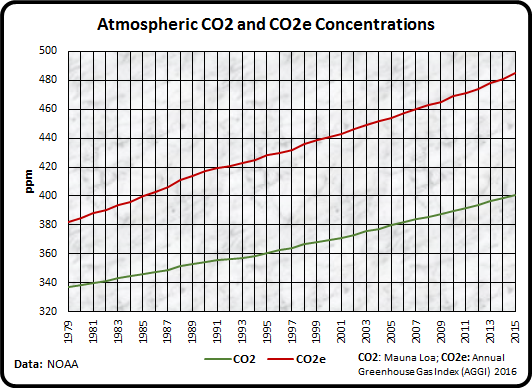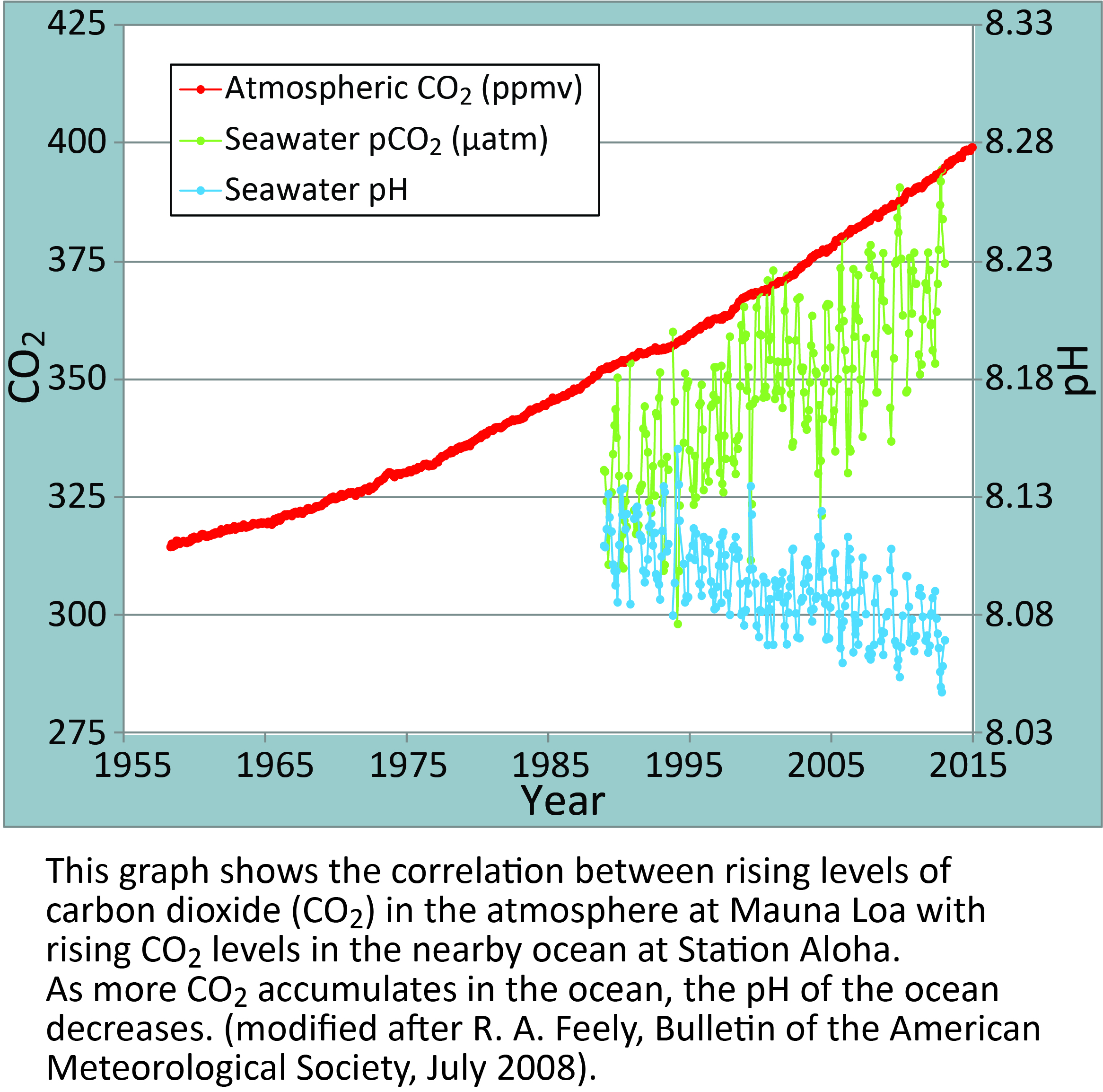General Discussion
Related: Editorials & Other Articles, Issue Forums, Alliance Forums, Region ForumsHere are some scientific facts I accept. (re Climate Change)
NOAA has just released its Annual Greenhouse Gas Index. It is an authoritative aggregation of all GHGs (CO2, CH4, N2O, CFC12, CFC11 and 15 minor GHGs) scaled for radiative forcing factors, and aggregated into a single number called CO2 equivalent or CO2e. This graph shows both the growth of CO2 alone and CO2e.

From this data we can derive the growth of the non-CO2 GHGs in ppm-equivalent, and compare the growth rate of those gases to the growth rate of CO2 itself. The results are "disturbing".
From 1979 to 2015:
- CO2 concentrations grew by 64 ppm, or 19%, at an average of 0.48% per year
- CO2e concentration grew by 39 ppm, or 86%, at an average of 1.75% per year
A linear trend indicates that CO2e concentrations could reach 560 ppm by 2040. That implies a catastrophic short-term global average temperature rise of +3°C.
One factor that might interfere with this march over the cliff (the only one, so far as I can tell) is the growing possibility of a global economic crash by 2025. So on the one hand we have the frying pan, on the other hand is the fire.
GliderGuider
(21,088 posts)The Saudis could be bankrupt by 2020, the world's oceans are pretty much done (fish replaced by plastic), warming is entering an accelerated regime from the melting of the Arctic ice, methane feedbacks are waiting in the wings, the world is falling short of drinking water, the food supply is contaminated by glyphosate, and the world's population is still growing by another Germany every year. What could possibly go wrong?
It all makes American presidential politics look pretty picayune to me.
Agony
(2,605 posts)muriel_volestrangler
(101,307 posts)You're comparing the growth in non-CO2 gases, compared to their 1979 level, to the growth in CO2 compared to its 1979 level. But there is a 'natural' level of CO2 - the pre-industrial level - say 280 ppm. We're interested in the excess warming each produces, rather than what we've always had (and needed to keep us above freezing).
What would be a valid comparison would the excess of each over their pre-industrial levels (which might be as good as zero for the non-CO2 ones - while some methane comes naturally from marshes and ruminants, it might be negligible when averaged out for the whole globe - I don't know). So the increase in 'excess CO2' would be 64 ppm/(337 ppm-280 ppm)=112%.
GliderGuider
(21,088 posts)CO2 today is 142% the pre-industrial level. (280 to 400 ppm).
CH2 is at 250% the pre-industrial level (~700 to 1850 ppb)
N2O is at 120% the preindustrial level (~270 to 320 ppb).
Of course you need to include in the radiative forcing factor for each. I looked at the growth rate of (CO2e-CO2) because that includes the forcing factor calculations. It therefore indicates the recent increase in warming impact of those gases due to direct and indirect human emissions.
On edit: Since CH4 is the main non-CO2 GHG, the fact that it's rising so much faster than CO2 over both the long and short time frames indicates that the contribution non-CO2 gases is rising faster
The increase in CO2e is "only" 50% faster than CO2 alone (up 27% for CO2e since 1979 compared to 19% for CO2 alone.) But the point of the post is that the other gases are really putting the hurry-up on things, that the situation is getting worse faster than one would think if they look at only the CO2 levels.
muriel_volestrangler
(101,307 posts)for CO2 and the total - page 54, table 2.6: https://www.ipcc.ch/ipccreports/far/wg_I/ipcc_far_wg_I_chapter_02.pdf
Sum: 1.91 W m-2
of which 1.20 W m-2 was CO2
so 0.71 W m-2 was non-CO2. So the relative contributions to the warming was 1.2:0.71, or 1.69:1 CO2 to others up to 1980; and since 1979 (basically the same date) it's been 64:39, or 1.64:1. So they're still increasing at about the same relative proportions.
Or you can look at the annual emissions - from AR5 https://www.ipcc.ch/pdf/assessment-report/ar5/syr/AR5_SYR_FINAL_SPM.pdf Page 5 Figure SPM 2:
total CO2 share of the CO2 equivalent (fossil fuel, industrial, and land use change):
1970 55%+17%=72%
1990 59%+16%= 75%
2010 65%+11%=76%
So that too shows that the increase in CO2 emissions is just slightly faster than for the others, but by very little.
alarimer
(16,245 posts)That's why they're called facts.
riderinthestorm
(23,272 posts)BIG K&R albeit with a lot of fear and sadness...
GliderGuider
(21,088 posts)That seems to rate a big fat ![]()
I understand that this is first and foremost a political board, but I would have thought that the severity of the global crisis would have penetrated the bubble by now.
lunatica
(53,410 posts)1939
(1,683 posts)which seems to confirm a lot of historical references
http://www.longrangeweather.com/global_temperatures.htm
